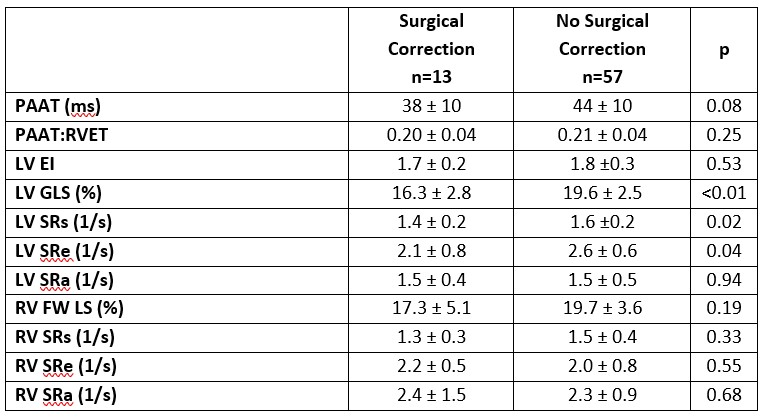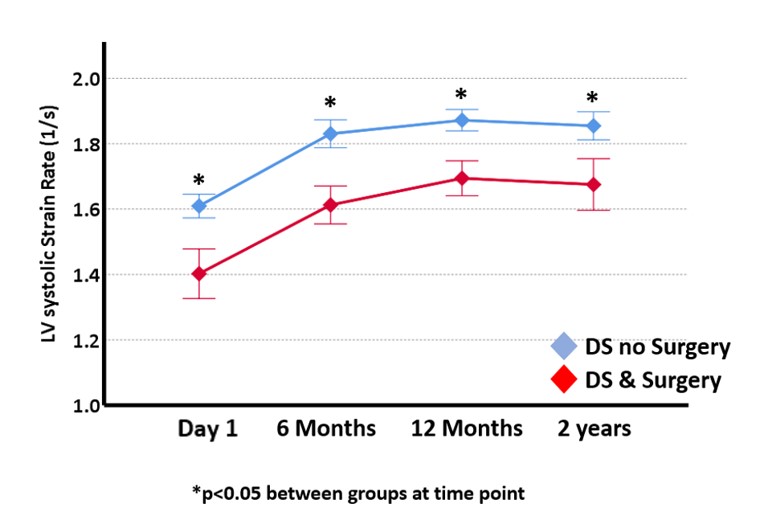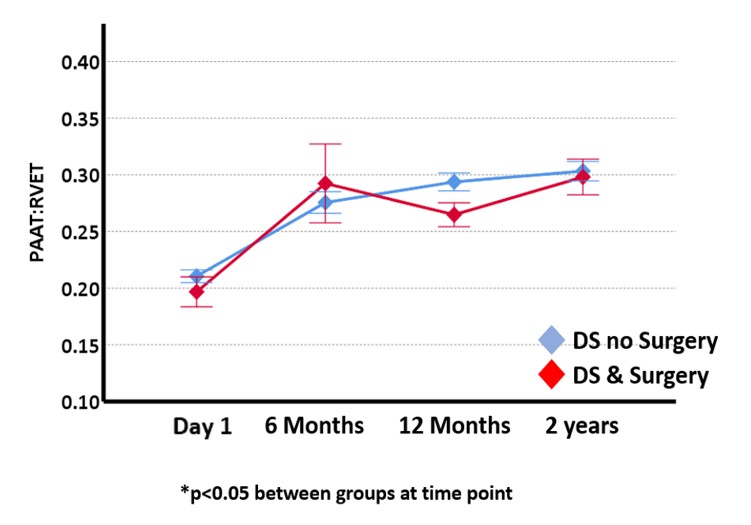Neonatal Hemodynamics and Cardiovascular Medicine 3
Session: Neonatal Hemodynamics and Cardiovascular Medicine 3
064 - Cardiac Function and Pulmonary Haemodynamics in Infants with Down Syndrome requiring Surgical Correction for Congenital Heart Disease over the First Two Years of Age
Saturday, April 26, 2025
2:30pm - 4:45pm HST
Publication Number: 64.4331
Aisling M. Smith, The Rotunda Hospital, Dublin, Dublin, Ireland; Philip Levy, Boston Children's Hospital, BROOKLINE, MA, United States; Eleanor J J. Molloy, Trinity College, Paediatrics and Child Health, Dublin, Dublin, Ireland; Naomi McCallion, royal college of surgeons in Ireland, Dublin, Dublin, Ireland; Orla M. Franklin, Trinity College Dublin, Dublin, Dublin, Ireland; Afif EL-Khuffash, Royal college of surgeons in Ireland, Dublin, Dublin, Ireland

Aisling M. Smith, PhD (she/her/hers)
Doctor
The Rotunda Hospital
Dublin, Dublin, Ireland
Presenting Author(s)
Background: Down Syndrome (DS) is associated with a significantly increased risk of congenital heart disease (CHD), with approximately 50% of infants with DS affected.
Objective: To test the hypothesise that babies with DS and CHD necessitating surgical correction may display altered biventricular myocardial performance and pulmonary haemodynamics compared to babies with DS not requiring surgical correction over the first two years of age.
Design/Methods: We prospectively enrolled 70 infants with DS of whom 13 required surgical correction for CHD over the first two years of age. Echocardiography scans were performed at six time points over the first two years: Day 1 (Echo 1), Day 2 (Echo 2) and Day 3-5 (Echo 3) and at 6 months (Echo 4); 12 months (Echo 5); and 2 years (Echo 6) of age.
Results: Infants with DS who required surgical correction for CHD (DS-Surg, n = 13) were compared to infants with DS who did not require surgical correction for CHD over the first two years of age (DS-no Surg, n = 57). Atrioventricular septal defect (n = 7, 54%), ventricular septal defect (n = 6, 46%) and atrial septal defect (n = 3, 23%) were the most frequent lesions. There were no differences in gestational age, birth weight, male sex or Caesarean section rates between the DS-Surg and DS- no Surg groups. Left ventricular (LV) global longitudinal strain (%), LV longitudinal systolic strain rate (1/s) and LV early diastolic strain rate (1/s) were all significantly lower on Day 1 evaluation in the DS-Surg group compared to the DS-no Surg group with 16.3 ± 2.8 vs 19.6 ± 2.5 (p < 0.01), 1.4 ± 0.2 vs 1.6 ± 0.2 (p = 0.02) and 2.1 ± 0.8 vs 2.6 ± 0.6 (p = 0.04) respectively (Table 1). LV longitudinal systolic strain rate measurements remained significantly lower in the DS-Surg vs DS-no Surg cohort throughout the first two years of age at all study time points (Figure 1). There were no differences in the pulmonary artery acceleration time to right ventricular ejection time ratio (PAAT:RVET) or LV eccentricity index (LV EI) between the DS-Surg versus DS-no Surg groups over the first two years of age (Figure 2).
Conclusion(s): In this study infants with DS requiring surgical correction of CHD were a markedly different sub-cohort of babies in terms of LV performance as early as Day 1. There were no differences between the DS-Surg and DS-no Surg groups with regards to indices of pulmonary haemdoynmics emphasising that the propensity of individuals with DS to elevated pulmonary arterial pressures is multi-factorial and influenced by factors beyond the surgical correction of CHD. Such findings delineate the DS-Surg cohort as particularly vulnerable.
Table 1: Day 1 echocardiography values in infants with Down syndrome who required surgical correction for congenital heart disease over the first two years of age.
 Values are presented as means (SD). A p value < 0.05 was considered significant.
Values are presented as means (SD). A p value < 0.05 was considered significant.Figure 1: Measurement of left ventricular longitudinal systolic strain rate by deformation analysis in infants with Down syndrome requiring surgical correction for congenital heart disease over the first two years of age.
 Values are presented as mean and standard error. DS: Down syndrome; LV: left ventricle.
Values are presented as mean and standard error. DS: Down syndrome; LV: left ventricle.Figure 2: Measurement of pulmonary artery acceleration time to right ventricular ejection time ratio in infants with Down syndrome requiring surgical correction for congenital heart disease over the first two years of age.
 Values are presented as mean and standard error. DS: Down syndrome; PAAT: pulmonary artery acceleration time; RVET: right ventricular ejection time.
Values are presented as mean and standard error. DS: Down syndrome; PAAT: pulmonary artery acceleration time; RVET: right ventricular ejection time. 
